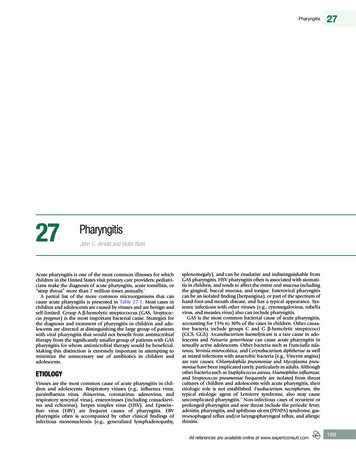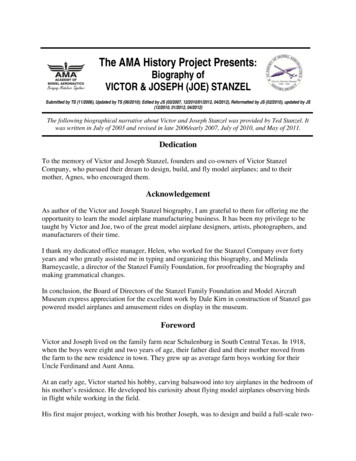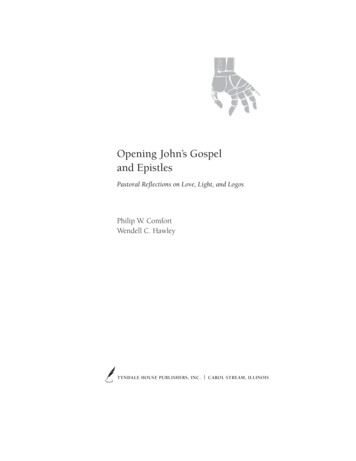
Transcription
Pharyngitis2727PharyngitisJohn C. Arnold and Victor NizetAcute pharyngitis is one of the most common illnesses for whichchildren in the United States visit primary care providers; pediatricians make the diagnosis of acute pharyngitis, acute tonsillitis, or“strep throat” more than 7 million times annually.1A partial list of the more common microorganisms that cancause acute pharyngitis is presented in Table 27-1. Most cases inchildren and adolescents are caused by viruses and are benign andself-limited. Group A β-hemolytic streptococcus (GAS, Streptococcus pyogenes) is the most important bacterial cause. Strategies forthe diagnosis and treatment of pharyngitis in children and adolescents are directed at distinguishing the large group of patientswith viral pharyngitis that would not benefit from antimicrobialtherapy from the significantly smaller group of patients with GASpharyngitis for whom antimicrobial therapy would be beneficial.Making this distinction is extremely important in attempting tominimize the unnecessary use of antibiotics in children andadolescents.ETIOLOGYViruses are the most common cause of acute pharyngitis in children and adolescents. Respiratory viruses (e.g., influenza virus,parainfluenza virus, rhinovirus, coronavirus, adenovirus, andrespiratory syncytial virus), enteroviruses (including coxsackievirus and echovirus), herpes simplex virus (HSV), and Epstein–Barr virus (EBV) are frequent causes of pharyngitis. EBVpharyngitis often is accompanied by other clinical findings ofinfectious mononucleosis (e.g., generalized lymphadenopathy,splenomegaly), and can be exudative and indistinguishable fromGAS pharyngitis. HSV pharyngitis often is associated with stomatitis in children, and tends to affect the entire oral mucosa includingthe gingival, buccal mucosa, and tongue. Enteroviral pharyngitiscan be an isolated finding (herpangina), or part of the spectrum ofhand-foot-and-mouth disease, and has a typical appearance. Systemic infections with other viruses (e.g., cytomegalovirus, rubellavirus, and measles virus) also can include pharyngitis.GAS is the most common bacterial cause of acute pharyngitis,accounting for 15% to 30% of the cases in children. Other causative bacteria include groups C and G β-hemolytic streptococci(GCS, GGS). Arcanobacterium haemolyticum is a rare cause in adolescents and Neisseria gonorrhoeae can cause acute pharyngitis insexually active adolescents. Other bacteria such as Francisella tularensis, Yersinia enterocolitica, and Corynebacterium diphtheriae as wellas mixed infections with anaerobic bacteria (e.g., Vincent angina)are rare causes. Chlamydophila pneumoniae and Mycoplasma pneumoniae have been implicated rarely, particularly in adults. Althoughother bacteria such as Staphylococcus aureus, Haemophilus influenzae,and Streptococcus pneumoniae frequently are isolated from throatcultures of children and adolescents with acute pharyngitis, theiretiologic role is not established. Fusobacterium necrophorum, thetypical etiologic agent of Lemierre syndrome, also may causeuncomplicated pharyngitis.2 Non-infectious cases of recurrent orprolonged pharyngitis and sore throat include the periodic fever,adenitis, pharyngitis, and aphthous ulcers (PFAPA) syndrome, gastroesophageal reflux and/or laryngopharyngeal reflux, and allergicrhinitis.All references are available online at www.expertconsult.com199
PART II Clinical Syndromes and Cardinal Features of Infectious Diseases: Approach to Diagnosis and Initial ManagementSECTION C Oral Infections and Upper and Middle Respiratory Tract InfectionsTABLE 27-1. Etiology of Acute PharyngitisEtiologic AgentAssociated Disorder(s) orClinical Findings(s)BacterialStreptococciGroup AScarlet feverGroups C and GMixed anaerobesVincent anginaNeisseria gonorrhoeaeCorynebacterium diphtheriaeDiphtheriaArcanobacterium haemolyticumScarlatiniform rashYersinia enterocoliticaEnterocolitisYersinia pestisPlagueFrancisella tularensisTularemiaFusobacterium necrophorumLemierre syndrome (jugular veinseptic thrombophlebitis)ViralRhinovirusCommon coldCoronavirusCommon coldAdenovirusPharyngoconjunctival fever; acuterespiratory diseaseHerpes simplex virus types 1and 2GingivostomatitisParainfluenza virusCommon cold; croupCoxsackievirus AHerpangina; hand, foot, and mouthdiseaseEpstein–Barr virusInfectious mononucleosisCytomegalovirusCytomegalovirus mononucleosisHuman immunodeficiency virus(HIV)Primary HIV infectionGonococcal pharyngitis occurs in sexually active adolescentsand young adults. The usual route of infection is through orogenital sexual contact. Sexual abuse must be considered strongly whenN. gonorrhoeae is isolated from the pharynx of a prepubertal child.Widespread immunization with diphtheria toxoid has made diphtheria a rare disease in the U.S., with 5 cases reported annuallyin recent years.GCS and GGS express many of the same toxins as GAS, including streptolysins S and O, and GCS pharyngitis can have clinicalfeatures similar to GAS and can cause elevation of serumantistreptolysin-O (ASO) antibody.3 GCS is a relatively commoncause of acute pharyngitis among college students and adults whoseek urgent care.4,5 Outbreaks of GCS pharyngitis related to consumption of contaminated food products (e.g., unpasteurized cowmilk) have been reported in families and schools.6 Although therealso are several well-documented foodborne outbreaks of GGSpharyngitis, the etiologic role of GGS in acute, endemic pharyngitis remains unclear. A community-wide outbreak of pharyngitisin children was described in which GGS was isolated from 25%of 222 consecutive children with acute pharyngitis seen in aprivate pediatric office; results of DNA fingerprinting suggestedthat 75% of isolates belonged to the same GGS clone.7The role of GCS and GGS in acute pharyngitis may be underestimated. Laboratories may use bacitracin susceptibility to identifyGAS; many GCS and GGS are bacitracin-resistant. Additionally,rapid antigen detection tests (RADTs) recognize the GAS cell wallcarbohydrate, but are nonreactive with GCS or GGS.8CLINICAL MANIFESTATIONSGroup A StreptococcusThe presence of certain clinical and epidemiologic findings suggests GAS as the cause of an episode of acute pharyngitis (Box27-1). Patients with GAS pharyngitis commonly present with sorethroat (usually of sudden onset), severe pain on swallowing, andfever. Headache, nausea, vomiting, and abdominal pain also canbe present. Examination typically reveals tonsillopharyngeal erythema with or without exudates, and tender, enlarged anteriorMycoplasmalAcute respiratory disease; pneumoniaBOX 27-1. Clinical and Epidemiologic Characteristics of Group Aβ-Hemolytic Streptococci (GAS) and Viral PharyngitisChlamydophila psittaciAcute respiratory disease; pneumoniaFEATURES SUGGESTIVE OF GAS ETIOLOGYChlamydophila pneumoniaePneumoniaSudden onsetSore throatFeverScarlet fever rashHeadacheNausea, vomiting, and abdominal painInflammation of pharynx and tonsilsPatchy discrete exudatesTender, enlarged anterior cervical nodesPatient aged 5–15 yearsPresentation in winter or early springHistory of exposureMycoplasma pneumoniaeChlamydialNon-Infectious EtiologiesGastroesophogeal reflux diseaseHeartburnLaryngopharyngeal refluxCough, hoarsenessPFAPA syndromePeriodic fever, aphthous ulcers,adenitisAllergic pharyngitisScratchy serration, post-nasal drip,hoarsenessHIV, human immunodeficiency virus.Modified from Bisno AL, Gerber MA, Gwaltney JM, et al. Practice guidelinefor the diagnosis and management of group A streptococcal pharyngitis.Clin Infect Dis 2002;35:113–125, with permission.EPIDEMIOLOGYMost cases of acute pharyngitis occur during the colder months ofthe year when respiratory viruses are prevalent. Spread amongfamily members in the home is a prominent feature of the epidem iology of most of these agents, with children being the majorreservoir. GAS pharyngitis is primarily a disease of children 5 to15 years of age, and, in temperate climates, prevalence is highestin winter and early spring. Enteroviral pharyngitis typically occursin the summer and early fall.200FEATURES SUGGESTIVE OF VIRAL DiarrheaCharacteristic exanthemsModified from Bisno AL, Gerber MA, Gwaltney JM, et al. Practice guidelinefor the diagnosis and management of group A streptococcal pharyngitis.Clin Infect Dis 2002;35:113–125, with permission.
Pharyngitiscervical lymph nodes. Other findings can include a beefy, red,swollen uvula; petechiae on the palate; and a scarlatiniform rash.No finding is specific for GAS. Many patients with GAS pharyngitisexhibit signs and symptoms that are milder than a “classic” caseof this illness. Some of these patients have bona fide GAS infection(i.e., have a rise in ASO antibodies), whereas others are merelycolonized and have an intercurrent viral infection. GAS pharyngitis in infants is uncommon, and is difficult to differentiate fromviral infections because nasopharyngitis, with purulent nasal discharge, and excoriated nares frequently accompany pharyngitis.Scarlet fever is associated with a characteristic rash that is causedby a pyrogenic exotoxin (erythrogenic toxin)-producing GAS, andoccurs in individuals who lack prior antitoxin antibodies. Althoughless common and less severe than in the past, the incidence ofscarlet fever is cyclical, depending on the prevalence of toxinproducing strains of GAS and the immune status of the population. The modes of transmission, age distribution, and otherepidemiologic features are otherwise similar to those of GASpharyngitis.The rash of scarlet fever appears within 24 to 48 hours of theonset of signs and symptoms and can be the first sign. The rashoften begins around the neck and spreads over the trunk andextremities. It is a diffuse, finely papular (sandpaper-like), erythematous eruption producing bright red discoloration of the skinthat blanches with pressure. Involvement often is more intensealong the creases in the antecubital area, axillae, and groin, andpetechiae along the creases can occur (Pastia lines). The faceusually is spared, although the cheeks can be erythematous withpallor around the mouth (Figure 27-1). After 3 to 4 days, the rashbegins to fade and is followed by fine desquamation, first on theface, progressing downward. Occasionally, sheet-like desquamation occurs around the fingernails periungually, the palms, andthe soles. Pharyngeal findings are the same as with GAS pharyngitis. In addition, the tongue usually is coated and the papillae areswollen. With desquamation, the reddened papillae are prominent, giving the tongue a strawberry appearance.VirusesThe presence of certain clinical findings (e.g., conjunctivitis,cough, hoarseness, coryza, anterior stomatitis, discrete ulcerativelesions, viral exanthema, myalgia, and diarrhea) suggests a virusrather than GAS as the cause of an episode of acute pharyngitis(see Box 27-1).Adenovirus pharyngitis typically is associated with fever, erythema of the pharynx, enlarged tonsils with exudate, and enlargedcervical lymph nodes. Adenoviral pharyngitis can be associatedwith conjunctivitis, when illness is referred to as pharyngoconjunctival fever; pharyngitis can persist up to 7 days and conjunctivitisFigure 27-1. Child has group A streptococcal pharyngitis and scarlatiniformrash, with characteristic circumoral pallor. (Courtesy of J.H. Brien .)27up to 14 days, when both resolve spontaneously. Outbreaks ofpharyngoconjunctival fever have been associated with transmission in swimming pools; widespread epidemics and sporadiccases also occur.Enteroviruses (coxsackievirus, echovirus, and enteroviruses) areassociated with erythematous pharyngitis but tonsillar exudateand cervical lymphadenopathy are unusual. Fever can be prominent. Resolution usually occurs within a few days. Herpangina isa specific syndrome caused by coxsackieviruses A or B or echoviruses and is characterized by fever and painful, discrete, grey-whitepapulovesicular/ulcerative lesions on an erythematous base inthe posterior oropharynx (Figure 27-2). Hand-foot-and-mouthdisease is characterized by painful vesicles and ulcers throughoutthe oropharynx associated with vesicles on the palms, soles, andsometimes on the trunk or extremities. Enteroviral lesions usuallyresolve within 7 days.Primary oral HSV infections usually occur in young childrenand typically produce acute gingivostomatitis associated withulcerating vesicular lesions throughout the anterior mouth including the lips, sparing the posterior pharynx. HSV gingivostomatitiscan last up to 2 weeks and often is associated with high fever. Paincan be intense and the poor oral intake can lead to dehydration.In adolescents and adults HSV also can cause mild pharyngitisthat may or may not be associated with typical vesicular, ulceratinglesions.EBV pharyngitis during infectious mononucleosis can besevere, with clinical findings identical to those of GAS pharyngitis(Figure 27-3A). However, generalized lymphadenopathy andhepatosplenomegaly also can be present. Posterior cervical lymphadenopathy and presternal and periorbital edema are distinctive if present. Fever and pharyngitis typically last 1 to 3 weeks,whereas the lymphadenopathy and hepatosplenomegaly resolveover 3 to 6 weeks. Laboratory findings include the presence ofatypical lymphocytosis (Figure 27-3B), heterophile antibodies,viremia (by PCR), and specific antibodies to EBV antigens. Ifamoxicillin has been given, an intense maculopapular rash isexpected (Figure 27-3C).Other BacteriaA. haemolyticum pharyngitis can resemble GAS pharyngitis, including the presence of a scarlatiniform rash. Rarely, A. haemolyticumcan produce a membranous pharyngitis that can be confused withdiphtheria.Pharyngeal diphtheria is characterized by a greyish brown pseudomembrane that can be limited to one or both tonsils or canextend widely to involve the nares, uvula, soft palate, pharynx,larynx, and tracheobronchial tree. Involvement of the tracheobronchial tree can lead to life-threatening respiratory obstruction.Figure 27-2. Child with posterior pharyngeal grey-white papulovesicularlesions characteristic of enteroviral herpangina. (Courtesy of J.H. Brien .)All references are available online at www.expertconsult.com201
PART II Clinical Syndromes and Cardinal Features of Infectious Diseases: Approach to Diagnosis and Initial ManagementSECTION C Oral Infections and Upper and Middle Respiratory Tract InfectionsABCFigure 27-3. (A) Pharyngeal erythema and exudate of Epstein–Barr virus (EBV). (B) Peripheral blood smear showing atypical lymphocytes (arrows) in a patientwith EBV mononucleosis. Note the abundant cytoplasm with vacuoles, and deformation of cell by surrounding cells. (C) Diffuse erythematous raised rash inadolescent with EBV mononucleosis who received amoxicillin; note predominance on trunk and coalescence. (Courtesy of J.H. Brien .)Soft-tissue edema and prominent cervical and submental lymphadenopathy can cause a bull-neck appearance.Fusobacterium necrophorum may be a common cause of nonstreptococcal pharyngitis, occurring in as many as 10% of adolescents and young adults with pharyngitis.9 F. necrophorum appearsto cause typical signs of bacterial pharyngitis (high fever,odynophagia, lymphadenopathy, and exudative tonsillitis), andcan cause concomitant bacteremia.10 The frequency of progressionfrom tonsillitis to Lemierre syndrome is unknown.DIAGNOSISDistinguishing between GAS and viral pharyngitis is key to management in the U.S. Scoring systems that incorporate clinical andepidemiologic features attempt to predict the probability that theillness is caused by GAS.11,12 Clinical scoring systems are helpfulin identifying patients at such low risk of GAS infection that athroat culture or RADT usually is unnecessary. However, in a 2012systematic review of 34 articles with individual symptoms andsigns of pharyngitis assessed and 15 articles with data on prediction rules, no symptoms or signs individually or combined intoprediction rules could be used to diagnose GAS pharyngitis witha probability of 85%.13 Adding to the complexity of diagnosis isthe ability to distinguish between GAS pharyngitis and other bacterial pathogens such as GCS, which have very similar clinicalmanifestations.3 Therefore, recent guidelines from the InfectiousDiseases Society of America (IDSA),14 as well as guidelines fromthe American Academy of Pediatrics (AAP)15 and the AmericanHeart Association (AHA),16 indicate that microbiologic confirmation (either with a throat culture or RADT) is required for thediagnosis of GAS pharyngitis.The decision to perform a microbiologic test on a child or adolescent with acute pharyngitis should be based on the clinical andepidemiologic characteristics of the illness (see Box 27-1). Ahistory of close contact with a documented case of GAS pharyngitis or high prevalence of GAS in the community also can behelpful. More selective use of diagnostic studies for GAS willincrease not only the proportion of positive test results, but alsothe percentage of patients with positive tests who are truly infectedrather than merely GAS carriers.Because adults infrequently are infected with GAS, and rarelydevelop rheumatic fever, 2001 practice guidelines from the Centersfor Disease Control and Prevention (CDC), the American Academyof Family Physicians (AAFP), and the American College ofPhysicians–American Society of Internal Medicine (ACP–ASIM)recommend the use of a clinical algorithm without microbiologicconfirmation as an acceptable approach to the diagnosis ofGAS pharyngitis in adults only.17 Although the goal of this202algorithm-based strategy was to reduce the inappropriate useof antibiotics in adults with pharyngitis, such an approachcould result in the administration of antimicrobial treatment to anunacceptably large number of adults with non-GAS pharyngitis.18According to a study intended to assess the impact of six different guidelines on the identification and treatment of GAS pharyngitis in children and adults,19 guidelines that recommendedselective use of RADTs and/or throat culture and treatment basedonly on positive test results significantly reduced the inappropriateuse of antibiotics in adults. In contrast, the empiric strategy proposed in the CDC/AAFP/ACP–ASIM guidelines resulted in theadministration of unnecessary antibiotics to an unacceptably largenumber of adults. Therefore, diagnosis of adults by symptomcomplex only has been discouraged by the latest AHA scientificstatement.16Throat CultureCulture on sheep blood agar of a specimen obtained by throatswab is the standard laboratory procedure for the microbiologicconfirmation of GAS pharyngitis.20 If performed correctly, athroat culture has a sensitivity of 90% to 95%.21 A negative resultcan occur if the patient has received an antibiotic prior tosampling.Several variables impact on the accuracy of throat culture results.One of the most important is the manner in which the swab isobtained.22,23 Throat swab specimens should be obtained from thesurface of both tonsils (or tonsillar fossae) and the posterior pharyngeal wall. Other areas of the pharynx and mouth are notacceptable sampling sites and should not be touched during theprocedure.Anaerobic incubation and the use of selective culture mediahave been reported to increase the sensitivity of throat cultures.24,25However, data regarding the impact of the atmosphere of incubation and the culture media are conflicting, and, in the absence ofdefinite benefit, the increased cost and effort associated withanaerobic incubation and selective culture media are difficult tojustify.25–28Duration of incubation can impact the yield of throat cultures.Cultures should be incubated at 35 C to 37 C for at least 18 to24 hours prior to reading. An additional overnight incubation atroom temperature, however, identifies substantially more positivecultures. In a study performed in patients with pharyngitis andnegative RADT, 40% of positive GAS cultures were negative after24 hours of incubation but positive after 48 hours.29 Therefore,although initial therapeutic decisions can be guided by negativeresult at 24 hours, it is advisable to wait 48 hours for definitiveresults.
PharyngitisThe clinical significance of the number of colonies of GASpresent on inoculated agar is controversial. Although density ofbacteria is likely to be greater in patients with bona fide acute GASpharyngitis than in GAS carriers, there is too much overlap in thecolony counts to permit differentiation on the basis of degree ofpositivity alone.26The bacitracin disk test is the most widely used method inphysicians’ offices for the differentiation of GAS from otherβ-hemolytic streptococci on a sheep blood agar plate. This testprovides a presumptive identification based on the observationthat 95% of GAS demonstrate a zone of inhibition around a diskcontaining 0.04 units of bacitracin, whereas 83% to 97% ofnon-GAS are not inhibited by bacitracin.26 An alternative andhighly specific method for the differentiation of β-hemolytic streptococci is the performance of a group-specific cell wall carbohydrate antigen detection test directly on isolated bacterial coloniesfor which commercial kits are available. Additional expense forthe minimal improvement in accuracy may not be justified.26Rapid Antigen Detection TestsRADTs developed for the identification of GAS directly from throatswabs are more expensive than blood agar cultures, but offer speedin providing results. Rapid identification and treatment of patientswith GAS pharyngitis can reduce the risk of the spread of GAS,allow the patient to return to school or work sooner, and speedclinical improvement.21,30 In addition, in certain environments(e.g., emergency departments) the use of RADTs compared withthroat cultures has significantly increased the number of patientsappropriately treated for GAS pharyngitis.31,32The majority of currently available RADTs have specificities of 95% compared with blood agar cultures.33 Therapeutic decisions,therefore, can be made with confidence on the basis of a positiveRADT result. However, the sensitivity of RADTs is between 70%and 90%.33 Although some patients with falsely negative RADTresults merely are GAS carriers, a large proportion truly are infectedwith GAS.34The first RADTs utilized latex agglutination methodology, wererelatively insensitive, and had unclear endpoints.33 Subsequenttests based on enzyme immunoassay techniques had a moresharply defined endpoint and increased sensitivity. RADTs usingoptical immunoassay (OIA) and chemiluminescent DNA probesmay be more sensitive than other RADTs and perhaps even assensitive as blood agar plate cultures,33 but because of conflictingand limited data about the OIA and other commercially availableRADTs, advisory groups still recommend a confirmatory bloodagar culture for children and adolescents who are suspected onclinical grounds of having GAS pharyngitis and have a negativeRADT result.The relative sensitivities of different RADTs can only be determined by direct comparisons in the same study. There have beenonly five reports of direct comparisons of different RADTs.35–39Only a handful of studies have investigated the performance ofRADTs in actual clinical practice and physician investigators haveconcluded differently about adequacy of test performance.29,36–41 Inone study,29 performed over three winter periods and using on-siteoffice testing in a pediatric group practice, RADT had a sensitivityof approximately 85% compared with a single blood agar plateculture. Investigators in a different pediatric group practicereviewed their experience with 11,427 RADTs performed between1996 and 1999.42 Only 2.4% of specimens negative by RADT werepositive by culture.42 A retrospective review of over 19,000 clinicalRADTs performed in a heterogeneous inpatient and outpatientgroup demonstrated a negative predictive value (NPV) rangingfrom 90% to 96% and a maximum sensitivity of 77% to 86%.39Physicians electing to use any RADT in children and adolescentswithout culture backup of negative results should do so only afterdemonstrating with adequate sample size calculation that theRADT is as sensitive as throat culture in their own practice.14,15Neither blood agar culture nor RADT accurately differentiatesindividuals with GAS pharyngitis from carriers. However, use facilitates withholding antimicrobial therapy in the great majority of27patients with GAS sore throat. There are an estimated 6.7 millionvisits to primary care providers by adults who complain of sorethroat each year in the U.S.; antimicrobial therapy historically wasprescribed at 73% of these visits.43 With encouragement for judicious use of antibiotics, trends show a modest decline in the use inchildren and adolescents diagnosed with pharyngitis to 69% in onestudy in 1999 to 2000,44 and to 54% in another study in 2003.45Follow-up TestingThe majority of asymptomatic persons who have a positive throatculture or RADT after completing a course of appropriate antimicrobial therapy for GAS pharyngitis are GAS carriers,46 thereforefollow-up testing is not indicated routinely. Follow-up throatculture (or RADT) for an asymptomatic individual should be performed only in those with a history of rheumatic fever, and shouldbe considered in patients who develop acute pharyngitis duringoutbreaks of acute rheumatic fever or poststreptococcal acuteglomerulonephritis, and in individuals in closed or semi-closedcommunities during outbreaks of GAS pharyngitis.46Other Diagnostic ConsiderationsAntistreptococcal antibody titers have no value in the diagnosis ofacute GAS pharyngitis, but are useful in prospective epidemiologicstudies to differentiate true GAS infections from GAS carriage.Antistreptococcal antibodies are valuable for confirmation of priorGAS infections in patients suspected of having acute rheumaticfever or other non-suppurative complications.Polymerase chain reaction (PCR) testing for GAS from tonsillartissue has been shown to be highly sensitive,47 but is not currentlyavailable clinically, and expense likely will restrict its use in clinicalpractice.The need to definitively diagnose non-GAS causes of pharyngitisoccurs rarely and generally only in those who are very ill or haveprolonged symptoms. A. haemolyticum will not be identified usingstandard throat culture methods (intended to identify only GAS),and requires use of standard respiratory culture methods. N. gonorrhoeae can be identified either by selective growth media or byusing nucleic acid amplification tests. EBV is routinely diagnosedusing the heterophile antibody (monospot), but low sensitivity inyounger children necessitates the use of specific antibody testingor serum PCR. Other common viruses such as HSV, adenoviruses,and enteroviruses could be identified in general viral cultures and/or by PCR.TREATMENTAntimicrobial therapy is indicated for individuals with symptomatic pharyngitis after the presence of GAS has been confirmedby throat culture or RADT. In situations in which the clinical andepidemiologic findings are highly suggestive of GAS, antimicrobial therapy can be initiated while awaiting microbiologic confirmation, provided that such therapy is discontinued if culture orRADT is negative. Antimicrobial therapy for GAS pharyngitisshortens the clinical course of the illness.30 However, GAS pharyngitis usually is self limited, and most signs and symptoms resolvespontaneously within 3 or 4 days of onset.48 In addition, initiationof antimicrobial therapy can be delayed for up to 9 days after theonset of GAS pharyngitis and still prevent the occurrence of acuterheumatic fever.49Antimicrobial AgentsPenicillin and its congeners (such as ampicillin and amoxicillin),as well as numerous cephalosporins, macrolides, and clindamycin, are effective treatment for GAS pharyngitis. Several advisorygroups have recommended penicillin as the treatment of choicefor this infection.14,15,50 GAS has remained exquisitely susceptibleto β-lactam agents over five decades.51 Amoxicillin often is usedbecause of acceptable taste of suspension; efficacy appears to equalpenicillin. Orally administered macrolides (clarithromycin andAll references are available online at www.expertconsult.com203
PART II Clinical Syndromes and Cardinal Features of Infectious Diseases: Approach to Diagnosis and Initial ManagementSECTION C Oral Infections and Upper and Middle Respiratory Tract Infectionserythromycin) or azalides (azithromycin) also are effective (seebelow). Sulfa drugs, including trimethoprim/sulfamethoxazole,and tetracyclines are not effective and should not be used for GASpharyngitis.Following a meta-analysis of 35 clinical trials completedbetween 1970 and 1999 in which a cephalosporin was comparedwith penicillin for the treatment of GAS tonsillopharyngitis, it wasfirst suggested that cephalosporins should be the treatment ofchoice for GAS tonsillopharyngitis.52 However, several methodologic flaws (most notably, the inclusion of GAS carriers) have ledto controversy regarding this conclusion.53 Indirect evidence of thesuperiority of cephalosporins over penicillins to prevent treatmentfailures and relapses continues to appear;54,55 however, there hasnot been a prospective study to clarify the issue beyond doubt.Although the use of cephalosporins for GAS pharyngitis couldreduce the number of persons (especially chronic carriers) whoharbor GAS after completing therapy, empiric first-line use wouldbe associated with substantial economic and possibly ecologiccost. There are compelling reasons (e.g., its narrow antimicrobialspectrum, low cost, and impressive safety profile) to continue touse penicillin as the drug of choice for uncomplicated GAS pharyngitis. Selected use of a first-generation cephalosporin as the drugof choice may be appropriate for patients at high risk of complications (such as a history of rheumatic fever), with severe symptoms,or with a suspected treatment failure or relaps
All references are available online at www.expertconsult.com 27 Pharyngitis John C. Arnold and Victor Nizet Acute pharyngitis is one of the most common illnesses for which children in the United States visit primary care providers; pediatri-cians make the diagnosis of acute pharyngitis, acute tonsillitis, or










